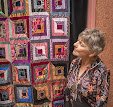A Study in Turkey Red
A Study in Turkey Red
What links this Turkey Red quilt with Charles Dickens,
West Cumbrian history and the history of the dyeing industry in Scotland
In 2010, I acquired
four quilts from Mrs. Oxtoby, of Wigton, West Cumbria . Mrs. Oxtoby and her family have lived in Wigton for
many generations and the quilts had belonged to her mother, Mrs. Smith, née
Sharp, who had died earlier that year. The quilts were found in a trunk in the
attic when Mrs Oxtoby was clearing her mother’s house to put it on the market.
(Reassuring to know that, even in the 21st century, there are
still attics which have not been ransacked for items to sell on Ebay!)
Although the
quilts are in various states of wear and condition, I was delighted to be able
to add such excellent examples of quilts with local provenance, displaying all
the characteristics of quilts made in this region of the UK
All four quilts are pieced entirely in cotton
and contain cotton wadding. The hand-quilting is competent without being
outstanding, and appears to be uniform over the four quilts. There are no
labels or identifying marks on any of the quilts, but they are typical of those
produced in the late nineteenth/early twentieth century.
Even if local
provenance hadn't been available, I would have felt confident in saying that
they had been made locally, for two reasons: the four quilts are quilted in the
particular pattern traditionally associated with the quilts of West Cumbria and
found also in geographically associated regions, which is to say South-West
Scotland, Northern Ireland and the Isle of Man; the pattern is known as ‘All over
Wave pattern’ and takes the form of a series of chevrons covering the entire
surface. The second clue is in the use of a particular red fabric, known as Turkey
red, in one of the quilts. This fabric is ubiquitous in quilts of our region for
reasons connected to the dyeing industry in Scotland
Mrs. Oxtoby was
able to tell me that other members of the family remembered the quilts and
believed that they had been made by two sisters, Sara and Mary Eliza McMechan,
whose family had a close friendship with Mrs. Oxtoby’s mother’s family, the
Sharps. It is believed that the quilts were given to the Sharp family as a gift.
The two sisters,
neither of whom married, were the daughters of Thomas McMechan, the founder of
the Wigton Advertiser. He had premises
in King
Street Cumberland
After Thomas’s
death in 1914, the Wigton Advertiser was published by his two daughters and, on
their retirement, by the Wilson
Evidence of the
close friendship between the family of Mrs. Oxtoby’s mother, the Sharps, and
the McMechans is in the Will of Mary Eliza McMechan, in which she bequeathed
legacies to Mr. Henry Sharp and his two daughters, one of whom was Mrs.
Oxtoby’s mother.
What, one might
wonder, were Charles Dickens and Wilkie Collins doing in Wigton? On 7th
September 1857
they had embarked on a walking tour in the north of England London Carlisle by train, then travelled another 14 miles to the village of Hesketh Newmarket
Their stay in
Wigton was brief, because on 9th September they travelled on to
Allonby. Arriving there in time for lunch, they stopped for two nights at The
Ship, described by Dickens as ‘a capital little homely inn looking out upon the
sea – a clean, nice place in a rough wild country.’ The landlord was Benjamin
Partridge whose ‘immensely fat’ wife was ‘very obliging and comfortable.’ The
Ship Inn is still there and a wall-plaque commemorates the famous visit.
So, there’s the
Dickens link - tenuous, I admit! But what links this Turkey Scotland
Before the
introduction of synthetic dyes, the colour red was mainly derived from the use
of the dried roots of the madder plant: Rubia tinctorum. But until the C17th
no method had been discovered in Europe whereby cotton fabrics could be dyed red which would
be fast to light and water - in other words, they would not fade or bleed. So when vividly-coloured, painted and printed cotton textiles, which
would withstand washing and sunlight, began to be imported by the East India
Company, European producers were keen to learn the dyeing processes by which they
were produced. The existing producers, mainly in parts of
the Turkish Empire like Greece and the Levant, hence the ‘Turkey red’
description, were understandably secretive about their processes, but in the
1740s determined efforts were made by Europeans to discover those secrets. Britain
Pierre Jacques
Papillon was first wooed by the Manchester Glasgow Glasgow Turkey
So there’s the
link: my Turkey red quilt reflects the fact that proximity to the centre of production
of Turkey red fabric meant that it was easily available to fabric retailers in the
North of England, hence the ubiquity of its use in quilts made in our region.
Not, of course, that Turkey
The history of Turkey red dyeing is long and complex and the above is a very brief, and far from scholarly, introduction to the subject. There's lots more information available on-line and it's the subject of several books and academic publications.
The history of Turkey red dyeing is long and complex and the above is a very brief, and far from scholarly, introduction to the subject. There's lots more information available on-line and it's the subject of several books and academic publications.
©CME 2017


